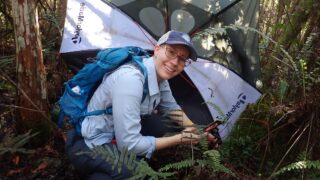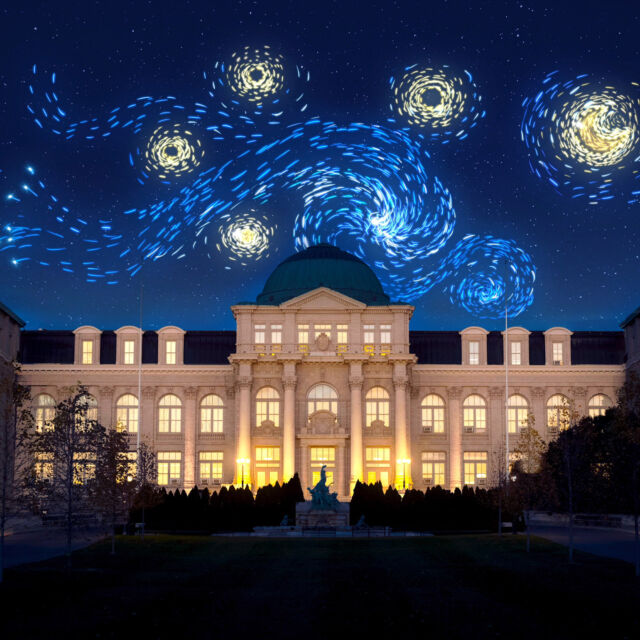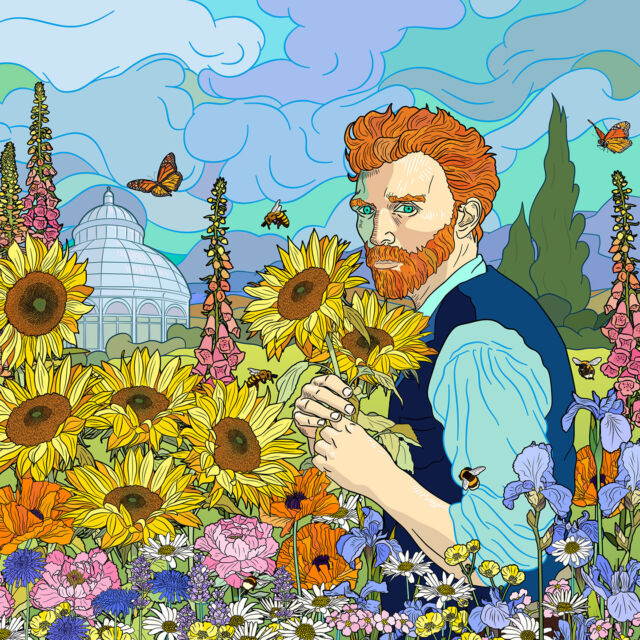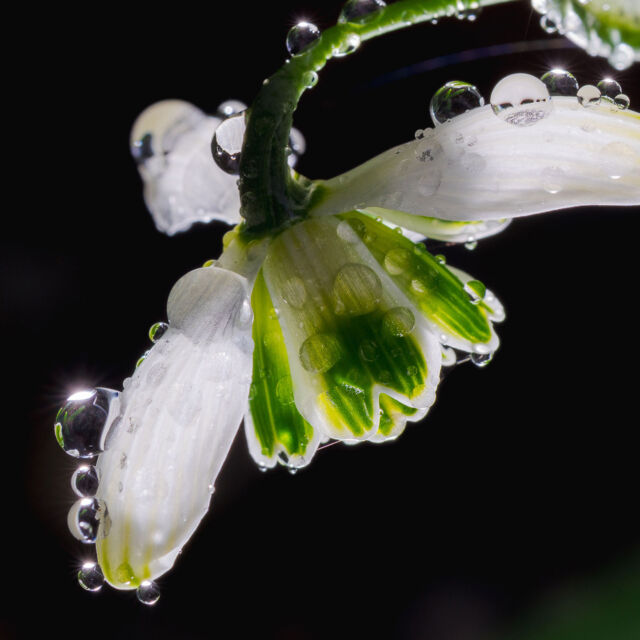How Ferns Inspired Dr. Emily Sessa’s Lifelong Career
Dr. Emily Sessa’s office is flooded with light—fit for a scientist who studies plants. She sits facing out onto the Garden, from a perfect vantage point overlooking the grounds—and the flora encompassed within. Plants have been a mainstay of Sessa’s life, starting in childhood and driving her interests in researching one of the lesser understood, yet incredibly important plant groups: the ferns.
During her childhood in upstate New York, Sessa loved exploring the woods, where she developed a strong affinity for plants. To her, they were “much prettier to look at than animals.”
“They have so many incredible colors, shapes, and patterns,” said Sessa. “Also, plants sit still, which is a really helpful thing when you’re studying them.”

Dr. Emily Sessa out in the field. Photo by Rita Bauer.
Good thing, too—her undergraduate studies at Cornell University were filled with plants, in one way or another. Most consisted of ecology and evolutionary biology, with a major focus on research in wetlands, and especially mosses.
After graduation, Sessa worked at the Museum of the Earth in Ithaca for a couple of years, and marks that time as the beginning of her love affair with public science venues and collections-based institutions.
“I fell in love with … places that blend research and education and learning about the world,” she said. “And then also, communicating that to the public.”
From there, she went on to pursue her doctoral degree at the University of Wisconsin, Madison, in the Botany Department, where she first fell in love with ferns. She did her postdoctoral training in plant genomics at the University of Arizona, then then went on to serve as a faculty member at the University of Florida for almost 10 years.
After that, Sessa moved to NYBG—which combined all of her interests: botany, research, education, and biodiversity collections. The Garden also gave her an opportunity to share her work with a wider public audience.
At NYBG, Emily Sessa holds two titles: Patricia K. Holmgren Director of the William and Lynda Steere Herbarium, and researcher. These roles inform and mutually advance plant science. What ties them together are plants—plant specimens, to be exact.
Herbaria are like libraries—only instead of books on shelves, they have plant and fungi specimens, either dried and glued to paper, or stored in a variety of boxes, books, and jars, for preservation and research. NYBG’s Steere Herbarium holds 7.8 million specimens and counting.
Collections like the Steere Herbarium are at the heart of all biodiversity research. Scientists who study biodiversity collect samples as part of their research, and these specimens are deposited in one of the world’s thousands of biodiversity collections for permanent preservation. For plants and fungi, herbaria fill this role. There, the specimens can be authenticated, properly stored, and digitized for sharing with the global community. Specimens contribute to the scientific record and document the Earth’s flora, fauna, and funga, and are used extensively by scientists conducting their own research. In fact, a research paper won’t be published, nor will a scientific journal accept it, if it doesn’t incorporate a list of specimens and note the herbarium or other collection in which they live.
“[Herbaria] are the bedrock of botanical science, and are critical tools for understanding the world’s plants and fungi—everything from crops to climate change.”

As for her own research, Sessa studies plant evolution and ecology, and her main foci is a particularly unassuming group of plants: the ferns.
“I’ve always been really drawn to the underdog plants,” said Sessa. “Mosses, ferns—things that don’t get as much attention as other plants do.”
What are ferns?
Chances are, you’ve crossed paths with one.
Let’s start with what they are not:
- Ferns are not angiosperms (flowering plants). Angiosperms reproduce with flowers, and bear seeds in fruits.
- Ferns are not gymnosperms (seed-producing plants like conifers, cycads, and ginkgoes—some of the oldest trees known). Gymnosperms reproduce with cones, and do not have fruits.
- Ferns are not bryophytes (mosses, liverworts, and hornworts). Bryophytes are also seedless, but they do not have vascular tissue, which ferns do.
Ferns are:
- A group of land plants that have roots, stems, and leaves, and that contain vascular tissue (xylem and phloem), but lack flowers and seeds. They reproduce with spores.
It was her graduate research on these seemingly straightforward plants that solidified Sessa’s career, one that has since focused on ferns near continuously. Though when asked about what made her cozy up with these friendly fronds, she says there was nothing that groundbreaking or earth-shattering that did it. Really, she was drawn to their beauty. After that initial spark, the rest fell into place.
“Honestly, they’re just so beautiful,” said Sessa, referencing the visual intricacy of ferns: fiddle heads, leaf patterns, and spore structures.

Photo by Dr. Emily Sessa.
“When I started to study them, it was really clear that we knew so much less about them than we do about flowering plants, which makes sense, given how important flowering plants are,” she said. “But these other plants like mosses and ferns, they all play really important roles too … but we don’t know a lot about them because they’re not as showy and flashy. And I think I felt an affinity for that.”
It’s true—ferns aren’t the most flamboyant of flora. They don’t produce flowers, they (usually) grow low to the ground, and are found all over the world—mostly in shady, damp forests. But if you look more closely, there are many characteristics of ferns that set them apart. One of their most striking features is their ability to survive. Ferns survived the mass extinction that wiped out the dinosaurs and went on to thrive in the cold, dark environment that followed. Stay tuned for the next installment on Dr. Sessa’s work with ferns and what we can apply from their ability to survive to our current environmental crises.
Want to hear more from Dr. Emily Sessa? Check her out on our first episode of Plant People, the NYBG podcast.
SUBSCRIBE
Enter your email address to subscribe to this blog and receive updates on new posts.











